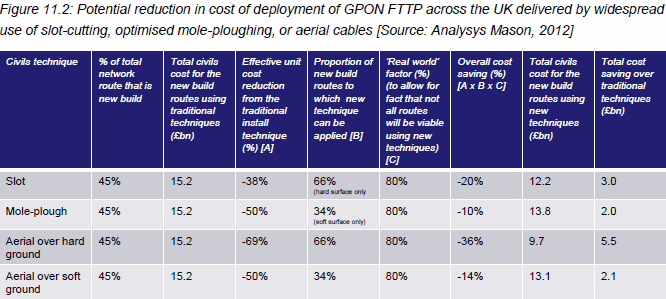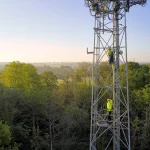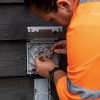Evolution in Fibre Optic FTTP Broadband Deployment Could Cut Costs by 10%
Ofcom has published a new Analysys Mason report that examines the cost of various civil engineering technologies for deploying superfast fibre optic broadband ISP services in the United Kingdom. It reveals that roll-out costs could be slashed by 10% if some of the latest innovations were adopted by BT and others.
The report, which is not to be confused with a similar EU study from earlier this week (here), suggests that developments in this area tend to be “evolutionary rather than revolutionary in nature“. But even a cost reduction of around 10% could have a significant impact because infrastructure deployment isn’t cheap and accounts for around 80% of the overall expense (estimates vary).
Advertisement
Analysys Mason Statement
“We have estimated the cost reduction that could be realised from adopting slot-cutting, optimised mole-ploughing and aerial cables on a wide-scale in the UK. As a baseline, we have taken Analysys Mason’s estimate for the cost of nationwide FTTP GPON coverage from the work we did for the Broadband Stakeholder Group, namely GBP24.6 billion. That total is based on the use of traditional civils techniques, and includes assumptions on duct re-use, volume of new-build, and unit costs for traditional install in different kinds of terrain.
By modifying the unit install costs (estimated using information received from interviewees during the course of our study) and also applying a ‘real-world’ deployment factor to reflect the fact that in practice each technique can only be applied to a percentage of eligible areas, we have estimated the potential benefit of the three techniques.”
At present the current deployment methods tend to favour underground installation.

The study suggests that the use of slot-cutting in hard surfaces could potentially deliver a cost saving of GBP3 billion (12% of the total cost), whilst mole-ploughing could deliver a saving of GBP2.0 billion (8% of the total cost).
On top of that the use of aerial cables instead of slot-cutting and mole-ploughing in new build routes could deliver a maximum cost saving of GBP7.6 billion (31% of the total), although the report said it was “questionable whether aerial could be used at such scale efficiently“.
In addition the report suggests that these savings “only be delivered if the techniques were adopted by industry on a widespread basis“, which would apparently require “successful commercialisation of the relevant recent or expected technical developments“. Easier said than done.
Advertisement
Ofcoms Fibre Optic Deployment Cost Savings Study (PDF)
http://stakeholders.ofcom.org.uk/telecoms/policy/next-generation-access/..
Mark is a professional technology writer, IT consultant and computer engineer from Dorset (England), he also founded ISPreview in 1999 and enjoys analysing the latest telecoms and broadband developments. Find me on X (Twitter), Mastodon, Facebook, BlueSky, Threads.net and Linkedin.
« Ofcom Want UK 2Mbps Target Raised as Superfast Broadband Reaches 65%

















































Comments are closed